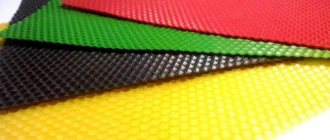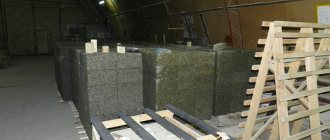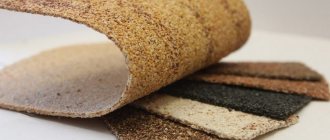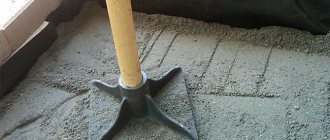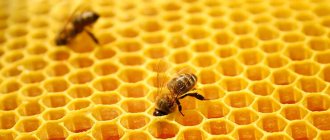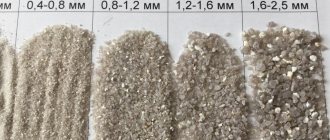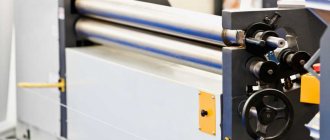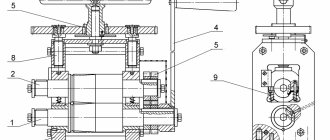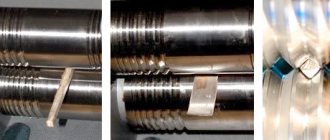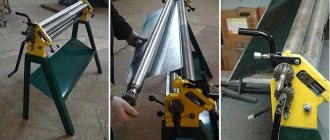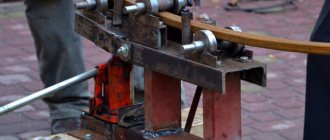What it is
Under natural conditions, bees independently build honeycombs, in which honey is later stored and offspring are hatched. In hives this happens a little differently. Frames with foundation are placed inside and the bees draw honeycombs from it. This makes the task easier for the workers, prevents swarming, and ensures offspring and productivity. This is a thin wax sheet, on the surface of which shallow hexagonal cells are extruded.
Placing frames in hives makes many tasks easier for insects and significantly increases honey collection. Insects calmly accept such a substitute in the space of their hive and begin to actively build honeycombs from this material. The process occurs much faster than it would in nature. Therefore, this has a beneficial effect on the development of the family and nectar collection. This thin wax sheet has a number of positive functions:
- preserves the physical health of the worker bee;
- expands the nest;
- prevents swarming;
- increases productivity;
- improves brood.
This solution with foundation is directly responsible for the health of the colony and preserves the physical strength of the bee.
What is natural wax and what does it look like?
This is the name given to a rectangular plate of beeswax placed in a hive on a special frame. Using the foundation as a preparation, the bees complete the honeycombs on it. On both sides the plate has hexagonal imprints similar to the bases of a honeycomb. To prevent the foundation from deforming, it is reinforced with metal wire.
High-quality foundation must be able to withstand the weight of filled honeycombs and a large number of bees.
The foundation has standard dimensions - 410 by 260 mm regular and 410 by 207 thick. From 1 kg of wax you can make 14–16 regular or 11–13 thick plates. Based on the size of the cells, they are divided into bee and drone cells. The distance between the parallel sides of the bee cell is 5.37 ±0.03 mm, the drone cell is 6.87 ±0.04 mm. The size of the angles that form the hexagon also matters. For large southern breeds, combs in which adjacent sides meet at an angle of 140° are suitable, for small Central Russian breeds - 120°. Honeycombs with a cell angle of 130° are considered universal and the most common.
Materials for making foundation
For the production of foundation, various materials : natural and artificial:
- Natural wax
- Wax. Foundation made from wax is considered natural; it is this kind of foundation that bees produce on their own;
- Wax-like artificial substances (paraffin, polyurethane and others). This foundation is considered more fragile and easily deformed; it is in little demand;
- Plastic. Artificial plastic foundation has a lot of advantages: long service life, no costs for purchasing natural wax foundation, hardness, wear resistance. The main disadvantage of such a plate is that the bees build uneven combs, or do not build them at all. In addition, plastic foundation must be regularly treated with chemicals to prevent infection and pests from appearing in the hive.
Advantages of homemade rollers
Manual rollers are the most convenient and practical, since they do not require electricity to operate. The clamps, which are fed by rollers and have a chain drive, are mounted on the main frame, and therefore they are more reliable, compact, easy to adjust and durable. Do-it-yourself production is a time-consuming and painstaking process, but it will cost much less than store-bought equipment.
Did you know? Bees can make not only hexagonal, but also pentagonal honeycombs. The latter are usually found between large and small cells.
What is it for and why is it used in beekeeping?
So, let’s repeat, the first reason is saving time. The beekeeping season lasts only a few months, and the bees have more than enough work. For example, just one insect a day flies over 1000 plants to collect the required amount of pollen. Secondly, life resources are also limited. A “equipped” hive with honeycombs made of foundation will allow you not to waste energy once again.
This leads to the third reason, beneficial to the beekeepers themselves. This is an increase in the volume of honey produced. But don't forget about safety. The main manufacturing principle is sterility. The wax is subjected to heat treatment. This prevents the entry of harmful bacteria.
Making wax with your own hands at home
Although it is difficult to make wax with your own hands, you can master this science. To do this, you will need to study the assembly technology, as well as prepare the tools for the job.
Tools and materials for work
You will need the following tools:
- pipe frame;
- U-shaped profile;
- threaded clamp;
- transmission chain.
Assembly technology
This process consists of the following steps:
- Mounting the main frame, which can be done using a pipe frame as a basis.
- Operation of the U-shaped profile. A deforming part of the mechanism is placed on top of the open part of this component, which is then secured using a threaded clamp.
- Operation of the transmission chain in order to assemble the mechanism.
- Mounting the chain on the sprockets. Then we pull it along the line and check it, and also install the feed handle.
- Manufacturing of rollers.
- Attach the rollers to the frames using rolling bearings.
Important! To make rollers, hardened steel is best. Thanks to it, the machine will last longer and be more reliable.
Possible manufacturing errors
During production, it is necessary not only to adhere to the collection technology, but also to avoid mistakes, which are the following:
- cracks on the surface;
- stretched surface at the point of greatest load;
- deformed parts.
Each of these errors will definitely have a negative impact on your machine, and therefore you need to do everything correctly, taking into account all the nuances and possible errors.
Did you know? The average working honey of a bee is 1/12 of one teaspoon.
Thus, making rollers yourself is quite difficult, but if you carefully study all the features of this process and adhere to the correct assembly technology, then this event will not be so difficult. But in any case, with this option you can save money and enjoy the convenience, compactness and reliability of the machine.
Equipment for the production of foundation: press
The finished factory machine consists of two weighted plates, fastened together with a gap of a certain thickness and with a relief surface in the form of hexagonal cells. To make it easier to remove the finished foundation, the inside of the press is moistened with water, after which wax is poured. The productivity of such equipment is low, and it is more suitable for amateur apiaries.
Building such a device at home is not particularly difficult:
To create a matrix with ready-made cells, one of the solutions (gypsum, silicone, epoxy resin, cement) is applied to a sheet of foundation; After one side has hardened, carefully separate the surfaces, and remove the remaining wax with hot water; The operation is repeated and the finished matrices are attached to the metal plates; After this, they are fastened together in such a way that after hardening the finished sheet has a given thickness.
Engraved rollers for foundation production - Metalist's Handbook
Wax pressed into relief sheets, as a foundation, is the basis for the construction of honeycombs by bees. To maintain the productivity of your own apiary, you will have to use foundation rollers. It is most profitable to do them yourself.
Foundation rollers
Features of making foundation
To obtain beekeeping products, it is important to create a high-quality base for them - foundation. It is not difficult to obtain if you have the equipment. Today, there are both vintage wax rental machines and new electrical equipment on sale. Special press machines are also used.
The natural product is wax pressed into a sheet, having a thin thickness and a cellular surface. Bees need cells for more efficient construction of honeycombs, as well as for producing strong and healthy offspring. Their depth and size should be as similar as possible to natural honeycomb cells.
Plastic foundation is also used. This is an artificial product that does not change properties for up to 10 years. It is also suitable for home honey production and bee colony raising, but has its disadvantages.
The use of artificial engraved plates leads to an increased risk of infection of apiary inhabitants with ascospherosis and other infectious diseases.
It is better to resort to making foundation on rollers, made on the basis of beeswax.
Types of rollers
Shafts for forming a relief sheet can be smooth or embossed (engraving). The former are less popular when obtaining a finished product for completing hives. Such devices are used only for the formation of blank sheets with the need to use a press with a relief working surface.
The equipment can be either manual or equipped with an electric drive. The second is more often used for industrial purposes. Conventional devices with a handle are also suitable for housekeeping.
Components of a hand-held device
Roller machines for rolling wax look like equipment for rolling out dough. The manual device is simple to use.
Its design is based on the operation of the main mechanism: the interaction of 2 cylindrical shafts connected by gears or a chain drive.
They are installed on a metal base (frame). For the stability of the structure, a clamp is used.
The shaft pressure is adjusted using a special spring or bolts. They rotate due to bearings and the rotational movement exerted by the control handle.
Manufacturing of hand-held equipment
The main advantage of assembling a wax rolling machine yourself is low cost. To make such a device, it will take 3-4 times less money than to buy a ready-made specialized device. You will need to get a drawing, according to which the preparation of materials and workpieces will be carried out.
The manufacturing process of rollers is complex and painstaking. To make rollers, the apiary owner needs to consider:
- Cell sizes on the finished product. They vary and depend on the maintenance of bees and the climatic characteristics of the region where the apiary is located. Before constructing the rollers, measurements are taken from the cells.
- Materials. For the manufacture of rollers, it is important to use strong and durable materials that will not affect the chemical composition of the finished product (pressed wax sheets). It is better to use cylindrical blanks made of food-grade aluminum.
- The cell angle should be 120°, since the cells of natural honeycombs have the same indicator.
The simplest and cheapest type to manufacture is a two-roller model with a gear or chain connection. Provided you have all the materials and tools, it will take only 4-5 hours to make such a device.
The manufacturing process of rollers is complex and painstaking
Intended use of the device
The first thing the apiary owner will have to deal with is to prepare the main material for work (wax). Excess liquid must be evaporated from it by boiling the product 2-3 times in an enamel container.
The production of foundation at home using a homemade machine is no different from the use of purchased specialized rollers. The surface is dipped into a bath with a special solution of warm water, soap and glycerin. The addition of a specialized product, royal jelly, is optional.
Having prepared the equipment, release solution and wax, you can test the rollers for making foundation yourself:
- Check the readiness of all equipment mechanisms for operation. It is important to adjust the gap between the shafts.
- The wax is dipped into a bath of solution.
- Carefully adjust it towards the gap between the shafts.
- The handle is turned, putting the equipment mechanism into action.
- The output is already rolled wax of the required thickness and with the presence of cells.
When producing a compressed product, the condition of the surface of the aluminum rollers is monitored. The wax should not stick to it. When the work is completed, the working parts of the equipment are washed with warm water and dried.
Conclusion
It is difficult to make a machine for producing wax sheets with your own hands, especially without experience working on drilling and lathe machines. If you have such experience, having obtained an aluminum cylinder, a metal pipe or profile, as well as gears, a chain and bolts, you will be able to construct a machine for rolling wax.
Foundation for bees at home
The machine that produces foundation is called a roller. The tool can be found in retail outlets or built with your own hands. The complexity of the mechanism lies in the relief surface: the dimensions of the cells must match the dimensions of the honeycombs that bees make.
The main components of the design include:
- 2 engraved drums that are coated with a polymer composition to prevent wax sticking;
- adjustable bolts that allow you to reduce or increase the interval between shafts;
- 2 gears that give the rollers forward rotation;
- a base that serves as a mount for other pieces of equipment.
Attention! The quality parameter of honeycombs is compliance with equal dimensions of cell angles of 120°. Only the fulfillment of this condition on the convex surface of the rollers will allow the production of high-quality foundation.
The initial stage when rolling sheets of wax is the release of blanks.
There are two main methods:
- Pouring into pre-prepared forms. The cleaned and dissolved wax is poured into prepared molds with wooden sides, which are moistened with water ahead of time. The finished sheet, after hardening, is put through the machine. At the output, the workpiece is thicker than the specified value, so the sheet is similar to tape, which is later brought to the standard.
- Coating the sheet with wax. The moistened plywood sheet is placed several times in liquid wax. When they want to get a thin sheet - two, if thicker - more. The two sheets are removed after cooling and run through the rollers. Such a workpiece comes out thinner: based on the size of the mold, the dimensions of the final product are adjusted. Minimum cuttings are obtained.
On a note. For the production of sheets, rollers with a flat surface are used only. The working surfaces (convex and smooth) are treated in advance with a release mixture. Honey or a suspension is used as a solution: glycerin (2 tsp) and unscented liquid soap (100 g) are mixed into 1 liter of liquid.
Equipment
Do-it-yourself foundation and its creation will not require purchasing expensive special equipment. You can buy a press and hand rollers.
Requirements for selecting devices:
- the texture is high quality and safe;
- aluminum rollers and workspace are coated with tin and nickel;
- purchase of prepared forms;
- purchasing a cooling system to preserve the cellular structure;
- The operating principle of a waxing machine is a waffle iron: pressing molten wax between two strips with dies.
The correct choice of design affects the technological process: it reduces the time for producing each sheet of wax.
Production begins with the calculation of the wax required for the production of plates. Calculations are carried out individually.
Production
Technological processes for producing plates are carried out step by step at home:
- Melt the wax, filter the liquid mass from impurities and debris.
- Set humidity. When the indicator is more than 2%, the liquid is evaporated over low heat.
- Melt over steam using two containers. Pull out the prepared sheet and throw it over the side of the bath.
- Pass the sheet between the rollers. Wax sticking is prevented by pre-cooling.
- It’s time to dry the foundation plates under normal conditions.
The disadvantage of making it yourself is the time it takes for the beekeeper, which takes him away from business. But automating your workshop will significantly reduce the time for wax processing.
Ready foundation sheets
Features of foundation production using rollers
This unit consists of the following components: 2 engraved shafts, 2 gears, adjusting bolts and a base.
The rollers are placed in a container with a separation solution. It is used to make the manufacturing process easier: in this way, the softened wax will not stick to the protrusions, and only high-quality “pits” of the required shape will be formed on the sheet.
This solution is sold in specialized stores, but you can make it yourself. To do this you will need: liquid honey or a solution of 1 liter of water, 100 g of liquid soap without fragrances and 2 tsp. glycerin to form a thin layer on the surface of the foundation with an odor that attracts bees.
Video: Rollers for foundation
The wax production process is as follows:
- The wax sheet is placed in the bath.
- This sheet is carefully moved towards the gap between the rollers and directed into it.
- The handle is turned away from you, and the rollers begin to rotate. Thanks to this process, the sheet will be completely placed in the gap and passed through it.
How exactly is it used in beekeeping?
Beginners understand what foundation is in beekeeping, but do not know how and when to install it. Everyone does it differently, but there are a number of general rules and tips:
- It is possible to substitute foundation into the hive only if there is a honey collection (trees or fields are blooming within a radius of 5 km from the apiary installation site) or when feeding with syrup, kandi or other nourishing food;
- there must be a fertile queen in the family, otherwise the bees will fill the foundation with honey, but the queen needs to sow it.
Fact: Many people practice beekeeping without foundation. From a scientific point of view, this is neither logical nor natural, but the choice remains with the beekeeper.
We make natural wax
Using this device is extremely simple. To work, you only need one ingredient - wax:
The required amount of wax is heated to a temperature of 90 degrees. It is best to use a special thermometer and after the wax reaches the required temperature, remove it from the heat. After that, cool the wax for 3-5 minutes so that it thickens slightly. Control the time and do not allow the product to lose the required liquid consistency, otherwise it will have to be reheated. Carefully pour a small amount of wax into the press in an even layer.
It is important not to overfill it, as otherwise it will be difficult to get rid of excess and unnecessary sheets. The finished foundation is removed from the press - and after a couple of minutes it is completely ready for use.
Experts recommend that novice beekeepers try both natural and artificial foundation. Only personal experience will help you understand which option is right for you and your bees, and which one will be easier for you personally to work with.
Rules for choosing foundation
When purchasing plates, it is recommended to consider the following parameters:
- material – natural wax, mixture with paraffin or polypropylene;
- appearance – cleanliness, transparency, intact structure;
- sheet sizes and weight - according to the standard, 2 varieties are produced: 400x260 mm, 70-80 g or 400x207 mm, 56-60 g;
- quantity, accuracy, cell sizes - hexagon type, concentration - at least 10 pieces per 5.5 cm, sizes vary.
The number and size of honeycombs made depends on the species characteristics of the bees, geographical location, and other reasons. For example, for Asian insects the cavities are smaller, but their number is greater than for European bees.
Types of material for manufacturing
- Natural wax. It is based on natural wax, but manufacturers sometimes add paraffin.
- Artificial (plastic) foundation. It is made from polypropylene or plastic. But the material has not yet received wide distribution.
Pros and cons of artificial foundation
Today's technologies offer more and more innovations. They also did not bypass beekeeping: many beekeepers switched from natural foundation to artificial one. This is due to a number of ADVANTAGES OF THE LATTER:
- Any wax foundation will envy the service life of plastic. You can actively use artificial leaves for up to 10 years.
- To make foundation with your own hands, you need to put in effort and time - or a significant amount of money to purchase. With plastic foundation, these problems are solved, since the cost in this case is more than affordable.
- No need for waxing is another important advantage. The plastic foundation is either immediately inserted into the groove, or the entire plastic frame is used.
- You can be sure that the plastic foundation will not warp in the evidence or in the honey extractor.
However, there are also significant disadvantages to using artificial foundation. It has to be treated with chemicals more often to prevent bee diseases, which is not very useful. In addition, the experience of using plastic foundation is not yet rich enough, so it is difficult to talk about how well the queen lays larvae on such foundation or whether the combs are built normally on plastic. Finally, plastic frames for foundation are quite problematic to make yourself, so you will need initial capital to purchase them.
How to make natural wax with your own hands?
DIY wax
To make natural wax you need to purchase a wax press. Such a device is purchased once and completely pays for itself, because without it it will be difficult to make natural foundation, and a purchased one will not be cheap!
Important!
There are many types of presses on sale; you need to buy the type that is suitable for frames in the apiary (dedan or rue), otherwise the finished foundation may not fit into the frames.
To make foundation, you need to heat the required amount of wax to 90 degrees. Then cool for 3-5 minutes until it thickens a little. Now the wax is poured into an even layer into the press and from there the ready-made foundation for the bees comes out in a couple of minutes.
As you can see, the method is very simple and does not require much effort, just a good press, wax and compliance with the temperature regime, as well as cooling time.
How to make a mini lathe yourself?
Any production must begin with the development of the project.
- At the design stage, specifications are developed. Specifications are a list of parts included in an assembly.
- There can be quite a lot of nodes in an installation. Some details may be repeated. But there may also be the presence of many very diverse blanks. The designer should strive to unify the parts used as much as possible, only then will the product be competitive in cost.
- After the first design stage, the selection of components begins. It will allow you to determine the actual design, where there will be a minimum number of original parts. Then it is easier to produce a working sample.
- When picking, parts are identified that are impossible to do without. They will have to be made. Everything else is cheaper to buy.
Lathe projections:
Most attention is paid to the headstock. The engine is located here, and a cartridge is installed at the same time. For wooden products, three-jaw fasteners are rarely used. Drive chucks are more often used; they require initial centering of the workpiece, and then installation of a driver, which will rotate the workpiece.
Lathe headstock option:
Some craftsmen make a drive from a drill. They have enough power (among modern power tools you can choose a drill up to 2…3 kW). They have a mechanism for smoothly changing the rotation speed. There is also a reverse.
Novice craftsmen are often interested in how much a small machine made by themselves costs. Sometimes a product will cost almost nothing, since components can be found for free. All that remains is to correctly assemble the machine and start using it effectively.
Foundation rollers
Rollers for the production of sheet foundation are a device consisting of two metal drums with a relief of cells , fixed with metal fasteners so that it is possible to pass a wax sheet through them, and at the output obtain foundation with stamped cells.
- Perhaps there is information here that will help you choose the special tool you need for making foundation
Rollers can be:
- Engraving. Using such rollers, you can form ready-made foundation with cell reliefs. Even with the help of manual engraving rollers, up to 20 kg of foundation can be produced per day;
- Smooth. Such rollers resemble a device for rolling out dough: smooth rollers help to form and prepare large volumes of blanks from wax briquettes for foundation sheets without reliefs.
Making foundation rollers
Every beekeeper knows what foundation rollers are. The manufacturing method is also known. But not everyone has the necessary equipment and is forced to purchase foundation in specialized stores. The production process is easy to make a profitable business, helping your own bees with this important element for their activities and selling part of the products.
What are foundation rollers?
At the production sites, wax is produced on automatic lines. At home and in outdoor apiaries, everything happens much easier. Rollers for making foundation are much more convenient and practical than a special press. To make foundation, simply pass a wax sheet through them.
Kinds
There are several types of such equipment on the modern market:
- engraved
- smooth;
- manual;
- with electric drive.
The difference in the shape of the surface of the rolls is that the engraved ones already have a characteristic pattern. By rolling out the plate, a hexagon-shaped workpiece appears on its surface, resembling a honeycomb. After this, all that remains is to shape it, secure it to the frame and place it in the hives. Then the bees will independently begin to pull the honeycombs, which are used to collect honey and brood.
Smooth rollers are used only to roll out the wax mass into sheets. The surface is smooth, without a pattern. Therefore, it is important to have both machines.
Foundation production using rollers
This is a profitable activity not only because of caring for your charges. There are statistics showing that in one season, using hand rollers, the owner rolls foundations worth close to 10 thousand dollars, without being distracted from his main occupation. Therefore, it is beneficial to use rollers for foundation production.
Making wax is not difficult. Each sheet takes no more than a minute. Prepare two rollers and clean wax, without traces of dead or debris. The technology is a bit like twisting clothes on old washing machines:
- lubricate the rollers with a weak soap solution so that the wax does not stick;
- add a little soda to the prepared solution;
- make a tape on smooth rollers or use one purchased in a store;
- move the finished tape or wax sheets onto the engraved roller and pass through it;
- The finished foundation is stored in a dark, cool place.
If you do not want to use a soap solution, you can use another product consisting of water, glycerin and liquid honey.
Home-made wax is no different from factory-made wax. But, since water (wetting solution) is used in production, it ends up in the sheets. Therefore, the finished sheets are in small stacks or 5-6 pieces. Store in a cool, well-ventilated area. And only after a few days they are chopped into piles for long-term storage.
Experienced beekeepers claim that the longer the foundation is stored in a warehouse, the better quality it becomes. It is not advisable to use freshly produced ones. This is another reason that should force you to produce a machine and produce an important product yourself and have a valuable beekeeping product in sufficient quantity.
Features of the technology
There is nothing special about preparing foundation on rollers. The most important thing is that the wax is clean, without foreign impurities. On dirty foundation, a bee may begin to pull drone combs.
The wax quickly warms up the rollers, and the sheets begin to stick. To prevent this from happening, you need to cover it with ice and remember to lubricate it with soapy water. Wax does not like high temperatures. It is better to maintain it within 15 degrees.
How to make rollers for making foundation
The price of rollers in the retail chain is high. Making your own machine for producing foundation is a rather labor-intensive process. But given the cost of finished equipment, it is advisable to master it.
Tools and materials
It is necessary to prepare the main components:
- two shafts;
- two gears;
- adjustment bolts;
- base for mounting the finished machine;
- work tool.
Assembling the device
The work is carried out in several stages:
- install the bed;
- a U-profile is suitable for a vertical base;
- use an additional chain for the mechanism;
- install the chain on the sprockets;
- make rollers using hardened steel or food-grade aluminum cylinders;
- cover with a silicone matrix, which you can make yourself;
- adjust the gap size;
- secure to the prepared base.
To give the matrix strength, add a small amount of building ceramics to it.
Some owners prefer to order the production of rollers from a milling machine with sufficient experience. Each cell should be perfectly identical. The lower shaft must be fixed on bearings, the upper one moves by the inertia of the first. The finished rollers produce at least 10 kg. wax in an hour.
The presence of a bathtub marked on the drawing is not necessary. But with her presence it is much easier to work. It contains roller liquid or melted wax. With its presence, there is no need to constantly manually lubricate the rollers. The same tray is used for making wax sheets.
It is filled with pure wax. A sheet of plywood or glass is generously moistened with water. Dip into melted wax several times. After hardening, it easily comes off and the plate is ready for scrolling. The melted wax can be poured into molds that look a little like a baking tray. The material frozen in them is also used.
But many beekeepers note that preparing sheets of semi-finished product is a painstaking and time-consuming task. Therefore, if there are no smooth rollers, but you have experience with engraved ones, then it is better to make a second machine.
Manufacturing errors
During the manufacture of a home machine, some errors occur. It is important to take them into account when starting independent work;
- cracks on shafts;
- reduction of clearance due to incorrect adjustment;
- compression of main parts and mechanisms.
Take these readings into account to prevent poor operation of the machine.
Advantages of home rollers
A handmade model made independently is painstaking, but profitable. Savings and additional benefits in business.
With little experience, every beekeeper can try to make such a machine. After work, it is important to monitor the condition of the shafts, wash and dry them. Lubricate bearings regularly.
In addition, it is important to observe the storage conditions of the equipment so that it lasts a long time.
Making foundation is an effective method that allows you to produce enough material for the insects to fully work.
Do not leave the bees without this material while he is looking for where to purchase factory material. Small size of the machine and no need to connect to the network.
He is present with the beekeeper during movements to honey-bearing places. And they are much easier to use than a press.
It is important to ensure that children or strangers do not try to pass paper or pieces of rags through the rollers. This cannot be done.
Foundation release technology
Creating your own workshop for the production of wax plates requires a special production technology. It is quite easy to use. With an increase in production volumes, it will be necessary to replace manual labor with automated devices. The order of technological operations:
- Kindling of raw materials - wax.
- Infusion, passing through a filter.
- Creation of plates using rollers located in a rotating drum.
- Substrate for the press, the thickness of the resulting sheet is from 4 mm.
- Leaving dents in the form of a honeycomb according to the manufacturing form.
- Separation of received sheets according to established sizes.
- Drying, packaging.
Rollers for wax production
Beekeepers use natural wax without adding other ingredients. Sometimes, to save money, they add a waxy substance produced in industrial conditions.
Workshop technical equipment
After studying the technological processes, equipment, tools, and materials for the production of foundation are purchased. Main mechanisms and devices: sterilizer, mechanized belt, rollers.
The last element included in the machine for the production of high-quality foundation is the basis of the technological process. Rollers require careful selection, since the result depends on them. They are mechanical and automated.
Each equipment manufacturer has different forms of production. Silicone matrices are widespread and have high quality, extended service life and convenience. If you don’t have the funds to buy an expensive device, then a plastic or cement matrix will do.
Types of foundation
With the advent of hives with removable frames, beekeepers began to think about how to speed up the production of new combs by bees. Attempts have been made to create a "middle wall" by making individual cells and gluing them together.
Usually foundation is made with the size of cells for the larvae of worker bees, but there is also drone foundation. True, it is more expensive and does not serve its intended purpose. Beekeepers use it for shops - the honeycombs are large and attractive to buyers of comb honey.
The corrugated plate can vary in different parameters, for example, in size and cell angles. The thickness and strength of foundation varies:
- store bought - the thinnest
- nesting
- reinforced - three layers of wax and wire reinforcement.
The material from which it is made also varies. In the old days, only natural wax was used. With the development of chemistry, foundation began to be produced from other raw materials. Now it happens:
- natural, made from pure wax,
- semi-artificial
- plastic (artificial)
Artificial foundation
There is no clearly established division yet. Some consider wax made with the addition of paraffin or other similar substances to be natural. When wax is replaced with plastic, artificial foundation is obtained. It has its merits. For example, its service life exceeds ten years. It is durable and bends easily.
But beekeepers are in no hurry to use it for a number of reasons. In the first place is the issue of environmental friendliness and its acceptance by the bees themselves. Plastic has an odor that bees don't like. Therefore, it is covered with wax using a brush. Buyers who are internally opposed to plastic want everything in their apiaries to be only natural. Its price is twice as high as wax.
Natural wax
First, about the semi-artificial one, which contains very little wax. Look at the photographs of melted records. There is no more than 10 percent wax in the photo. Such plates bend worse, are less durable, and “float” at a temperature lower than that of pure wax plates. The melting point of paraffin is 40-42 degrees, wax - up to 68.
The best material is natural wax without impurities. The bees eagerly begin building a new honeycomb. It is the most environmentally friendly and does not introduce foreign substances when melting wax.
Rules for storing foundation
Storage place - dry, cool room without foreign odors. Manufactured copies are packed in thick paper. The temperature and humidity in the room are constantly monitored to avoid overheating of the plates.
Beekeeping without wax sheets is almost impossible at present, since wax sheets increase the productivity and health of bee colonies. These are the main tasks of beekeepers. Making wax plates at home is easy to implement. This requires minimal equipment, skills and time.
Manufacturing
Experienced beekeepers usually have their own equipment for making foundation. After each collection, the wax is collected for further processing. It is not profitable to constantly buy new foundation. You can purchase ready-made equipment and do your own manufacturing. There are only two ways:
- dipping method;
- casting wax slabs.
The poppy method of production is practically not used today. This does not make it possible to obtain high-quality wax. Special dipping boards, which are moistened with water, are dipped into molten wax several times. After hardening, carefully remove using warm water. The edges are then trimmed and adjusted to the desired size. It is troublesome and the quality of such material cannot be called high.
Casting wax slabs is the simplest and most progressive manufacturing method. Purified, free of debris and impurities, molten wax is cast in special molds. The result is a sheet of standard size, the thickness of which is 1.5 cm. These sheets are then passed through smooth rollers until the thickness reaches 3 mm. At the last stage it is passed through engraving rollers.
In manufacturing, belt machines are used in which the wax tape is rolled first on smooth and then on engraving rollers. Then, on an automatic line, the sheets are cut into specific sizes, which is already foundation. High quality, durable, clean, not dangerous to bees.
Professional equipment
The use of such equipment allows us to produce high-quality foundation with a low percentage of defects in a very short time. Naturally, the price of professional equipment is high. The production line includes the following stages:
- A wax mixture is prepared from the starting material. Bee wax is used as a raw material, and sometimes a little industrial wax is added.
- The mixture is heated to sterilize.
- The wax passes between drums, which are cooled from the inside with water. According to the preliminary setting, a film of the required thickness is formed.
- The wax tape enters the pressing chamber. There its thickness under pressure decreases by 4 times.
- A relief imprint of a honeycomb is applied to the wax sheet on both sides.
- The foundation is cut into sheets of the required size, then dried and packaged.
Finished line
How to make wax with your own hands
Making honeycomb frames yourself is rare. However, starting a line at home for the production of foundation is quite simple.
Necessary equipment
You don't have to buy expensive equipment to create wax plates. It is possible to purchase hand rollers and a press. Rules for choosing devices:
- materials meet quality and safety requirements;
- rollers and working area made of aluminum coated with thin layers of nickel and tin;
- acquisition of ready-made production forms;
- additional purchase of a cooling system to preserve the cellular structure;
- The principle of operation of the assembled machine is a waffle iron, that is, compression of melted wax between two plates with matrices.
Press for wax production
With the correct selection of equipment, the technological process will minimize the time required to produce each wax sheet.
Preparation
Preparation of containers used for hot water, melted wax and the finished specimen. The stencil is created from available materials: wood, rubber. Silicone templates are most often purchased. Equipment parts must be treated with drying oil.
Stencil for foundation
Production begins with calculating the amount of wax required to produce a set number of plates. Calculations are performed individually.
Manufacturing
Step-by-step implementation of technological processes for producing plates at home:
- Melt the wax, clean the liquid mass from visible impurities and contaminants.
- Determine humidity. If it is above 2%, then evaporate the water by putting it on low heat.
- Melt over steam using two containers. Pull out the finished sheet and throw it over the edge of the bath.
- Pass the sheet between the rollers. They are pre-cooled to prevent the wax from sticking.
- Dry the finished foundation plates in natural conditions.
The disadvantage of independent production is that it wastes the beekeeper’s time, which distracts him from pressing matters in the apiary. However, when automating your own mini-shop, the wax processing time is noticeably reduced.
Foundation press
This is a fairly simple device with which you can obtain a limited amount of the finished product (the average productivity of a hand press is no more than 10 sheets per hour). Therefore, in large apiaries, the use of a press is impractical. The principle of operation of the device is similar to a waffle iron - the press consists of two halves with grooved internal parts. The factory press consists of two heavy plates, usually made of aluminum. They are connected to each other with a small gap, which is equal to the thickness of the sheet - from 0.2 to 0.6 mm. Sometimes beekeepers manage to convert old waffle irons into foundation presses, fixing silicone matrices for foundation inside.
Press for making foundation with your own hands
Despite its modest productivity, this type of foundation production machine is still consistently popular among beekeepers. Unfortunately, there are no domestically produced presses for sale, and the price of foreign tools goes through the roof for 50,000 rubles. For this money you can buy good rollers from a Russian or Ukrainian manufacturer. A simple press can be assembled independently without any problems or costs. For this you will need:
- Beeswax.
- Silicone for the mold. Any non-toxic variety of silicone or synthetic raw material used to make molds will do.
- Two wooden plates, fastening elements for the plates.
- Foundation sheet – 1 piece.
First of all, take one wooden plate and a ready-made sheet of foundation, and apply a layer of silicone to it. The silicone must be very carefully smoothed over the surface of the wax sheet so that all the cells are filled. Then silicone is applied to the plate itself and smoothed out thoroughly. Next, the foundation sheet is covered with a second layer of silicone, smoothed out, and connected to a wooden plate with the silicone-coated side.
As a result, the reverse side of the sheet remains clean, as does the second wooden plate. They are also treated with silicone in the same way.
The first layer of silicone is carefully smoothed over the surface, after applying the second layer, both wooden plates are connected to each other so that the wax sheet is between them.
Now you can attach metal loops to the wood-wax “sandwich” and wait until the silicone hardens completely. You can speed up this process by placing the structure in the oven and keeping it for some time at a temperature of 70-100 °C. Once the silicone is sufficiently strong, you can open the plates, attach the handle and additional side limit plates. For ease of use, you also need a tank into which excess wax will drain.
How to make wax on your press yourself
Working with the press is very simple: first, melted wax is evenly poured onto the lower wooden plate with a grooved silicone surface and pressed with the upper plate.
Important! There is no need to try to accurately calculate the amount of wax, its excess will flow into the tank and can be reused.
The remaining frozen wax on the edges of the plates can be cut off with a spatula. After this, the plates are unclenched, wait until the wax has completely hardened, and carefully remove the finished sheet.
To prevent the wax from sticking to the silicone, it is recommended to lubricate the matrix with a solution of laundry soap. However, as practice shows, sometimes bees build very poorly on foundation sheets that have traces of soap solution on them.
Important! Instead of a soap solution, it is recommended to use honey diluted in warm water as a lubricant for the silicone matrix (honey is full).
The result is a light, translucent corrugated sheet of fairly high quality. The only possible drawback of this design is that the edges of the hexagonal cells may be slightly less pronounced, which has virtually no effect on the construction of honeycombs by bees. Of course, this description of the wax production process is very superficial. In fact, every good beekeeper has his own secrets for making high-quality wax: special preparation of the wax, its repeated melting in a wax melter and in a water bath, dehydration, heating the press plates to a certain temperature, etc.
It is also worth considering the process of manufacturing plastic foundation in a press. In fact, it is not much different from making wax from natural material. You will need:
- Silicone (as a plastic substitute) and hardener for silicone.
- Spatula, tape.
- Actually, the press.
The workflow is as follows:
In a separate container, silicone and hardener are mixed in the required proportions. Using a spatula or knife, silicone is applied in an even layer to the matrix, after which it is pressed tightly on top with the press lid. After the silicone has hardened, the finished sheet is removed from the press and kept for some time until the artificial foundation has completely hardened.
Important! Before installing a plastic product in a frame, the surface must be covered with a thin layer of natural wax, since bees are very reluctant to build honeycombs on pure silicone.
Melt wax is applied to the silicone with a soft brush or roller. You can also dip the artificial foundation into melted wax - it will be faster.
Products made from silicone and other form-forming synthetic substances last quite a long time, and silicone matrices in a homemade press will last more than one season. The only condition is not to overheat the mold. Thus, using a press of even such a primitive design, it is possible to provide a small apiary with the necessary amount of natural, high-quality foundation.
Making foundation with your own hands: possible methods
A beekeeper, especially during the season, is always busy: inspecting hives, pumping out honey, forming families, preventive work, etc. Therefore, many prefer to exchange their raw materials for ready-made foundation.
Beekeepers who do not trust manufacturers or have difficulty selling wax obtained from melting, make foundation themselves, constantly inventing new techniques and using the most unexpected materials.
However, there are still only two main methods for making foundation at home:
- A special molding press , designed on the principle of a waffle iron: heated wax is poured inside, the doors are closed and some time is waited to harden;
- Special rollers through which the prepared wax sheet is rolled. Such a mechanism can be manually, electrically or mechanically controlled.
Each method has its own advantages and disadvantages, and when designing fixtures, the main difficulty is the construction of a safe and functional molding surface.
Advantages of home rollers
A handmade model made independently is painstaking, but profitable. Savings and additional benefits in business. With little experience, every beekeeper can try to make such a machine. After work, it is important to monitor the condition of the shafts, wash and dry them. Lubricate bearings regularly. In addition, it is important to observe the storage conditions of the equipment so that it lasts a long time.
Making foundation is an effective method that allows you to produce enough material for the insects to fully work. Do not leave the bees without this material while he is looking for where to purchase factory material. Small size of the machine and no need to connect to the network. He is present with the beekeeper during movements to honey-bearing places. And they are much easier to use than a press.
It is important to ensure that children or strangers do not try to pass paper or pieces of rags through the rollers. This cannot be done.
Step-by-step production of foundation sheets
- First of all, the master must clean the wax from mechanical impurities by boiling the wax in an enamel container several times.
- After cleansing, the water content of the mass should be no more than 2%; all excess must be removed. This can be done by evaporating the water from the wax over low heat on the stove. In the future, how much water is in the mass will determine the class of “honeycomb substitute” for bees.
- After the wax is prepared, the master will melt it in a steam bath, in two containers at the same time.
- You need to place the template in warm water to warm it up a little.
- After the melted wax has been processed, the artist moves on to the stage of pressing the sheet for the bees. To do this, you need to fill the unit’s bath with warm water and place the lower and upper press plates in it separately, heating them for 45-60 minutes.
- After this, the master must remove the lower part of the sheet. This event will allow excess liquid to drain and be thrown over the bathtub.
- Knead the prepared sheet of foundation; the quality and class of the finished result will directly depend on this.
- Remove the wax foundation sheet from the bath and place it on the lower matrix, remove the fastening pins from the guide mechanism.
- After this, the master can remove the jack and remove the upper part of the matrix.
- The finished result needs to be placed under a stream of cold water and the plate and wax sheet. Thus, the sheet will fully harden and will not crack or chip when moved, and the result will be a durable material and a high quality class.
- After this, the master can dry the sheet. Drying of the sheet should be carried out in a natural environment.
A simple way to make your own frame
The reliability of the bed is a key characteristic of the machine. Human safety and the quality of the product depend on the properties of the material and the quality of the connection of the parts of the frame.
Based on these requirements, the choice falls on metal profiles, chipboard, plywood or solid wood (preferably solid wood: oak, birch or the most common: pine).
If the choice is on a metal frame, then you need to choose a channel, an I-beam or a profile pipe that will carry the load-bearing functions of the machine. Here the choice depends solely on the availability of the material, its price and ease of installation. However, the metal frame is the simplest in design: you only need two I-beams, on which the engine, tailstock, tool rest and caliper are then mounted.
If the choice is wood or chipboard, then based on a preliminary sketch-drawing with the existing dimensions of the engine and all other elements, the design of the frame is formed. As a rule, it consists of a table top, which acts as a base, a stand for the tailstock and a box on which the motor and headstock axle are mounted.
In addition, two parallel slats are run between the headstock racks, on which a movable support board is attached. A gap of 5 cm is maintained between the slats. Afterwards, it is necessary to weld the frame with a welding machine - this will give additional strength to the structure.
If the machine is supposed to be a tabletop machine, then there is no need for legs, but when processing heavy and massive elements, the bed should be independent and its stability should not raise questions. In this case, it is necessary to provide legs. They are made from rolled steel, for example, angle or timber.
The dimensions of the machine primarily depend on the goals pursued by the master. Most operations at home are performed with products up to 80 cm in length, so most often the length dimensions of the machine are 80 cm. If the frame is made of metal, then two blanks of equal length are cut with a grinder.
Types: natural, with additives, plastic foundation
With the development of technology in beekeeping, not only natural, but also synthetic components began to be used in the production of foundation. Depending on the type of raw material from which it is made, foundation can be made from several types of materials:
- Natural. It is made from beeswax after it has been cleansed of impurities: propolis, wormwood, food residues. Such raw materials are very plastic and can be easily deformed, but natural foundation is easy to attach to the frame. Its main advantage is its naturalness;
- With additives. Paraffin (mainly) and other chemical compounds can be used as additives. Such raw materials are more resistant to temperature increases than natural ones, but are more fragile and harder to coat;
- Plastic . A completely artificial product that can last up to 10 years if treated with care, but cannot be restored after breakage. In addition, it requires mandatory coating with a thin layer of wax for better adaptation to the hive.
Organic fertilizer to increase the productivity of cultivated plants! “This is the only fertilizer today that works! Activates the development of the root system, ensures maximum yield, preserving the high taste of the fruit. Safe for soil and vegetables." To learn more
Important! If we consider the types by thickness, then the most popular among beekeepers is nesting foundation , 1 kg of which contains 18 sheets. Store-bought foundation is the thinnest (up to 65 sheets). However, it requires increased labor costs from bees. Reinforced wax contains 3 fewer sheets than nested wax, but is particularly strong because it consists of 3 layers of wax. This type is the most common in homemade production.
Foundation and rollers for its production: do it yourself
Any beekeeper is well aware of what foundation is and why it is needed. Rollers for making foundation yourself are also familiar to those who work with bees. It is this simple device that allows you to quickly and effectively help bees in such an important matter as the construction of honeycombs, in which honey will subsequently accumulate.
Rollers for making foundation
Types of foundation and methods of its production
Externally, foundation is a thin sheet made of wax or other materials, on both sides of which there are extruded depressions - bottoms. The recesses on the surface of the foundation are not round - they are made in the form of a hexagon. It is this cross-sectional shape that, as is known, each cell of a bee honeycomb has.
An alternative to foundation rollers is a press
Depending on the material from which it is made, foundation can be of several types:
- natural (this is the kind of foundation produced by the bees themselves, using wax);
- made on the basis of artificial materials close to wax in their characteristics;
- plastic, for the manufacture of which polypropylene is most often used (plastic foundation can be used many times, its service life sometimes reaches up to 10 years).
Natural wax naturally smells like wax, and its color ranges from light yellow to yellow.
Since plastic foundation is still very rarely used by domestic beekeepers, it is not advisable to discuss in detail the nuances of its production and use in this article.
The production of foundation, the material for which is wax or its artificial analogues, can be carried out using two main methods.
- To implement the first method, equipment for the production of foundation is used, such as rollers, which can be equipped with various types of drives - manual, mechanical, electric, etc. The working parts of the rollers have a cellular relief. It is between them that a preheated thin sheet of wax or its artificial analogue is passed.
- The second method of making foundation involves the use of a press, which can be equipped with a manual or electric drive. The main working parts of such a press are two plates, on the surface of which there are hexagonal protrusions. The latter form depressions in soft sheets of wax or other material. It should be noted that a press, compared to rollers, does not make it possible to make wax with high productivity, so it is advisable to use it only in cases where a small amount of wax sheets is needed.
